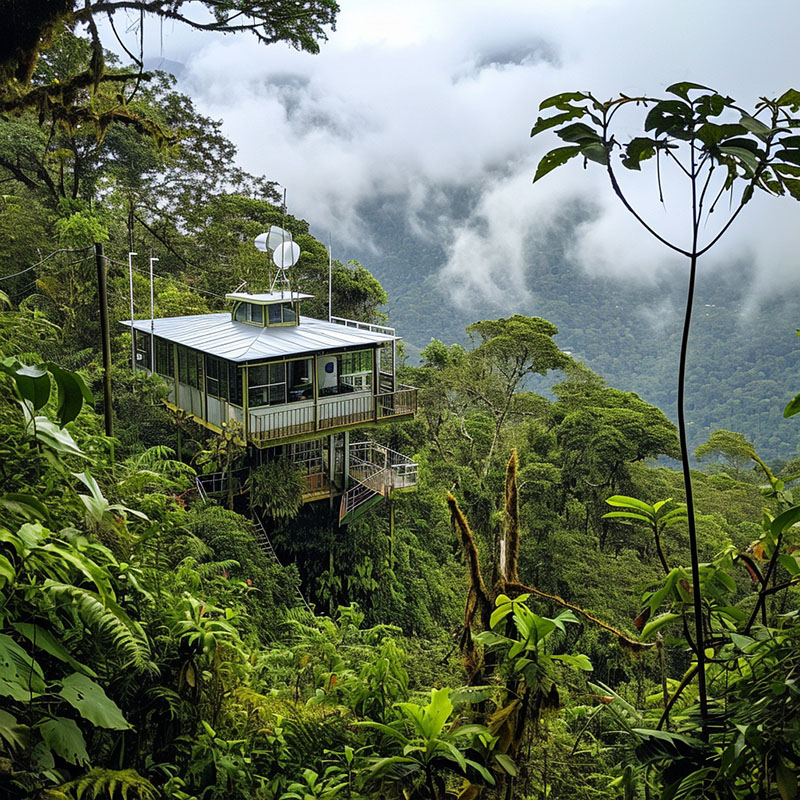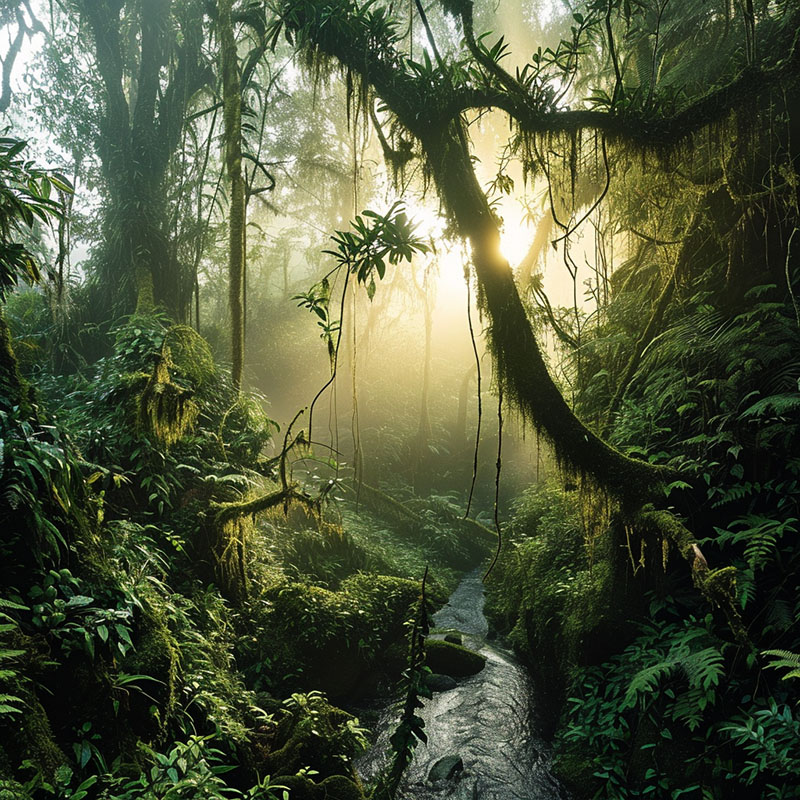
A cloud forest is a unique type of forest ecosystem that occurs in tropical or subtropical mountainous regions at higher elevations, usually between around 1,600 and 3,300 meters above sea level. Cloud forests are characterized by persistent fog or low-level clouds that cling to the slopes and surround the treetops.

Cloud forests are incredibly biodiverse, home to a wide variety of endemic plant and animal species that have specially adapted to thrive in the cool, extremely humid conditions. Many cloud forest trees and plants have adopted specialized water-absorbing strategies - thick mosses covering bark and leaves, bromeliads, and epiphytic orchids are common.

These forests provide essential ecoservices that impact regional and global ecology and climate.
- They regulate and purify water cycles like giant sponges, capturing moisture from the atmosphere and filtering rainfall. Many watersheds and freshwater systems rely on cloud forests.
- Their condensed moisture allows cloud forests to continue photosynthesis and carbon sequestration even during dry seasons, removing greenhouse gases from the atmosphere.
- The rich endemic biodiversity of rare flora and fauna contains unique genetic information still being discovered. Many cloud forest species remain undiscovered or at risk of extinction.

The Earth's cloud forests, vital and unique habitats for thousands of rare and endangered species, and suppliers of year-round water supplies for farmers, rural communities and many rapidly growing cities, are under increasing threat from factors including agriculture, road-building and climate change.
In 2004, figures from the first comprehensive survey of these rare, romantic and fragile worlds, indicated that cloud forests cover an area of just under 400,000 square kilometres, or less than 2.5 per cent of the globe's tropical rain forests.
One surprising finding is that, contrary to previous estimates, the majority of these moist humid forests are found in Asia rather than Latin America.
Indeed, the report, Cloud Forest Agenda, which is being launched at a meeting of the Convention on Biological Diversity in Kuala Lumpur, Malaysia, estimates that 60 per cent of cloud forests are found in Asia with around 25 per cent in Latin America and 15 per cent in Africa.
The findings underline the vital need for improved monitoring and conservation measures in Asia, including regeneration of damaged and degraded cloud forests, if these precious habitats are to survive the 21st century. Priority countries may include Indonesia and Papua New Guinea which have been found to hold considerable amounts of cloud forest.
The report makes it clear that conserving and restoring cloud forests is not a only a matter of aesthetics or a love of nature, but one of crucial economic importance for millions of people in the developing world.
The ability of cloud forests to strip and retain moisture from cloud and fogs is key to abundant, clean and predictable water supplies in many areas, especially during dry seasons. The cloud forests of La Tigra National Park in Honduras provide over 40 per cent of the water for the 850,000 people living in the capital, Tegucigalpa.
Other cities where cloud forests supply significant amounts of water include Quito, Ecuador, Mexico City and Dar Es Salaam. All the water used by the Tanzanian capital in the dry season for drinking and powering hydroelectricity originates in the cloud forests of the Uluguru Mountains.
The forests of Mount Kenya guarantee the dry-season river flows to the semi-arid lowlands with the headwaters of the River Tana supplying water to over five million people. River systems in the Mount Kenya area also supply other urban centres, Kenya's blossoming international exports of flowers, as well as wildlife and tourist centres.
The study, compiled by researchers from the United Nations Environment Programme's World Conservation Monitoring Centre (UNEP-WCMC) and colleagues from IUCN and the United Nations Educational, Scientific and Cultural Organization (UNESCO), is the first major report of the Mountain Cloud Forest Initiative (MCFI).
Klaus Toepfer, UNEP's Executive Director, said: "If we are to achieve the UN Millennium Development Goals and the World Summit on Sustainable Development's Plan of Implementation in areas such as improved provision of drinking water supplies and reversing the rate at which biodiversity is being lost, we need sound science upon which to act."
"This new report highlights how relatively small and special areas of the Earth play a disproportionately important role in meeting these targets and time-tables and that their continued loss will make realizing these international aims harder and harder. I hope this study will not only trigger improved awareness of the need to conserve cloud forests, but lead to new partnerships and initiatives to conserve and restore them. Good work in this area is already being undertaken in some countries. This report underscores how much more is needed, particularly in Africa and areas of Asia, now known to be holding significant reserves of these fragile mountain habitats," he said.
The findings will also be presented to environment minister and experts attending the 8th Special Session of UNEP's Governing Council and 5th Global Ministerial Environment Forum taking place in Jeju, South Korea, in late March where water will be high on the agenda.
The unique conditions found in cloud forests make them ideal breeding grounds for special species often found nowhere else in the world. Species found there include the endangered spectacted bear, the mountain gorillas of Africa and the Resplendent Quetzal, a colorful bird which is the national symbol of Guatemala.
The huge concentration of unique, endemic species is underscored by the Andean cloud forests. In Peru, over 30 per cent of the 272 species of endemic mammals, birds and frogs are found in cloud forests.
Even tiny pockets of cloud forest can harbour an extraordinary variety of life forms. For example, the Centinella Ridge in Western Ecuador has about 90 endemic plant species in a forest area of just 20 square kilometers.
New species are often being discovered in cloud forests. In the 1990s the Jocotoco Antipitta, a bird, was found in about 5,000 hectares of Ecuadorian cloud forest, as was the Scarlet-banded Barbet. It was discovered in cloud forest near the headwaters of the Rio Cushabatay, Peru.
A new genus of the cow family and two new species of barking deer were discovered in the Annamite cloud forests of Laos and Vietnam as recently as 1996.
Cloud forests are the natural habitats of the wild relatives of important crops and therefore important gene pools for crop improvements.
Recent studies have found wild living relatives of papaya, the tomato, tree tomato, passion fruit, avocado, beans, blackberry, cucumber, potato and peppers in cloud forests.
The report identifies nearly a dozen major threats to cloud forests including clearance for farming and grazing land and habitat fragmentation. Indeed, loss of habitat has been a particular problem for the spectacled bear in the Andes. Deforestation has affected migration routes and there have been conflicts with farmers where bears have been eating new crops. Wildlife corridors in cloud forests are essential if man and bear are to co-exist.
In Africa, 10 out of 15 countries questioned said poaching and hunting of animals such as great apes was a key threat. Fires were also highlighted as a key problem in African countries.
Seven out of ten Asian countries, including Indonesia, Malaysia and the Philippines, mentioned timber extraction and logging as an issue, with seven African and four Asian nations citing collection for fuelwood and charcoal production as a possible threat.
Road construction was cited as a threat in six Latin American countries. Studies in Puerto Rico indicate that cloud forest soils can take up to 300 years to recover from such construction. Road and tourists developments, including golf courses, are threatening forests in Southeast Asia, in Malaysia's Genting and Cameron Highlands and Sabah's Mount Kinabalu.
Clearance of cloud forests for either illegal opium or coca leaf is reported in Colombia, Bolivia, Peru and Venezuela. Introduction of alien species can also be an issue. Cloud forests in Jamaica are threatened by an introduced Australian tree, and feral pigs in Hawaiian cloud forests have led to plant and bird extinctions.
Some countries are now implementing innovative schemes to save cloud forests. Costa Rica, for example, under its 1996 Forest Law, pays landowners who conserve or re-establish forests. Hydro-electric companies also pay up to US$40 a hectare a year to landowners with cloud forests in recognition of their role in maintaining water supplies.
Cloud forest tourism can also be a valuable source of income for local people and thus a reason to conserve these habitats. The report cites schemes in Africa, including trips to see the mountain gorillas in the cloud forests of the Democratic Republic of the Congo, and others schemes in Asia and Latin America.